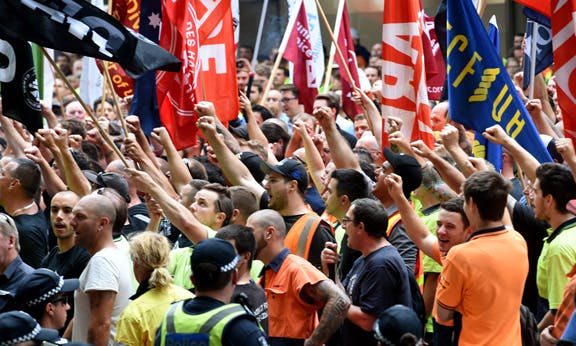What we need to revive our union movement

“I believe in the rule of law where the law is fair and the law is right. But when the law is unjust, I don’t think there’s a problem with breaking it.”
This unexpected and forthright declaration by the new secretary of the Australian Council of Trade Unions, Sally McManus, points to one important part of a strategy to revive our union movement. With the changing of the guard at Australia’s peak union body, it’s worth elaborating on some of the crucial elements of any union revival.
First: strikes – in defiance of the law if need be. No union revival in history has relied on Facebook memes. Every single union revival has relied on workers taking strike action to paralyse key sections of industry, and to keep doing so until the employers and the state give concessions. Every single union revival has fallen foul of anti-union laws, and pushed past them.
Second: organising drives. Of course, it’s not enough just to call for strikes; we have to organise for them. Most effective strikes rely on a serious and systematic approach to organising in advance – both organising the maximum number of workers to strike, and organising to sustain the strike through the logistical and political challenges that any serious class battle entails.
Unless we are organising the unorganised, we are going backwards as a movement. Capitalism is constantly destroying or relocating established industries, and creating and expanding new ones. There is no point in bemoaning the changing nature of the working class, the (often overstated) rise of insecure jobs and so on. Every generation of militants has faced new and serious challenges. A serious approach to organising, aiming at significant industrial action, is the only way these challenges have been overcome.
Third: radical class struggle politics. Our strategies and tactics are powerfully informed by, or limited by, our view of the world. A set of politics that accepts the limits laid down by the owners of industry and their pet politicians gives up a big part of the battle before it is even fought.
One proof of this is the fact that each of the three great union revivals of the last century has been intertwined with a revival in radical politics. In the 1900s and 1910s, revolutionary unionists known as syndicalists (most famously the Industrial Workers of the World, but a much broader layer than that) were crucial in rebuilding unions from the crushing industrial defeats and economic depression of the 1890s.
In the mid- and late 1930s, unionists informed by the politics of the Communist Party played a vital role in a series of disputes that turned the tide on Depression era union-busting. During the famous 1934 coal miners’ strike in Wonthaggi, perhaps the best prepared strike in Australian history, the entire workforce – and the entire town – mobilised into committees to organise picketing, food, entertainment and solidarity to sustain a five-month strike.
After the victory at Wonthaggi, Communists played a crucial role in spreading these tactics during the six-week national coal strike of 1938, described by some historians as the most effective national strike in Australian history. A union revival was well on its way.
In the late 1960s and 1970s, a broad radicalisation sparked by opposition to the US war in Vietnam spread over much of the world, including Australia. This political radicalisation underpinned the industrial explosion of May 1969, when a rolling, Australia-wide general strike led to the freeing of Melbourne tramways union leader Clarrie O’Shea – and the smashing of the anti-union “penal powers” laws that had tied down the union movement for a generation after World War Two.
In each of these cases, a crucial role was played by politicised militants who were prepared to push a struggle past the limits set by the majority of union officials of the time.
As the 1960s-70s wave of radicalisation faded, the Australian union movement turned sharply to class collaboration – and a deliberate forgetting of the militant strategies that had pushed the movement forward. Systematic organising drives followed by crippling industrial action, after all, aren’t really compatible with the class collaboration approach expressed in the 1983 Prices and Incomes Accord, and still overwhelmingly dominant in the union movement today.
So where does all this leave us now?
Every militant in the union movement will welcome as a breath of fresh air Sally McManus’ comments on defying unjust laws. We should also recognise that any genuine union revival will require a huge amount of work – painstaking and detailed organising, leading to dramatic and prolonged strikes.
One vital contribution to this will be winning a core of militants to the task of rebuilding a class struggle, and explicitly socialist, political current in this country.